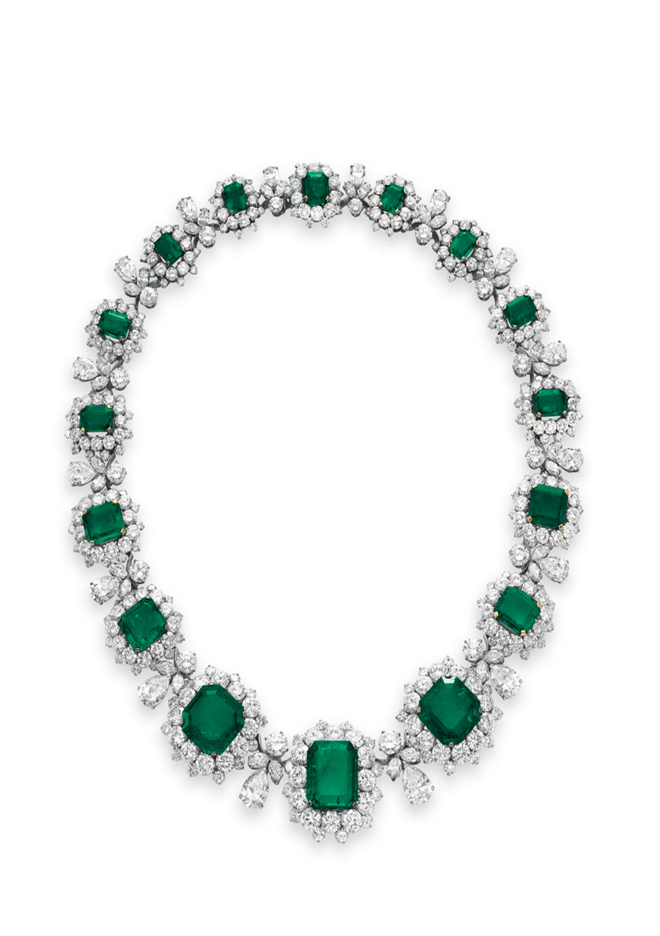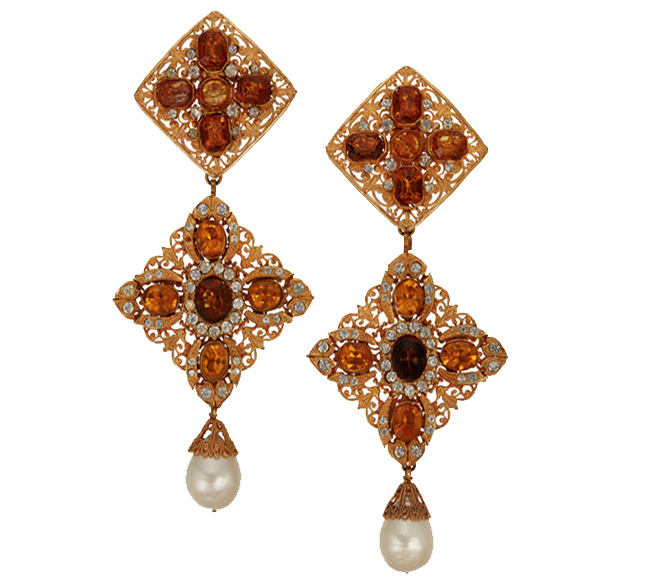The Extraordinary Beauty and Refined Elegance of Vintage Jewellery
Vintage jewellery possess an unexplainable allure and timelessness, which in some cases, justify them as sound investments.
If our marketplaces could speak, it would tell us that as a society, we are fascinated by objects that belong to a bygone era. Whether it’s classic cars, first edition books, Old Master paintings or stately homes passed down through the generations, these remnants of the past are celebrated and often considered to be significant, beautiful and of value. Much like the British upper classes who are renowned for prizing a carefully patched up suit that used to belong to a great grandfather far above a new one, many consumers in the 21st century tend to be governed by an age-old-saying, “They don’t make them like they used to” – and it’s often true.
With jewellery being of no exception, the extraordinary beauty and refined elegance of older designs, tend to possess an unexplainable allure and timelessness which justify them as sound investments. Whether you’re contemplating a Bvlgari Trombino ring, a stylish Cartier bracelet, or an ultra-rare set of Gripoix glass and faux pearl Chanel jewellery; here’s a brief introduction to various vintage bracelets, rings, earrings and necklaces that are particularly highly prized.
Vintage Bvlgari

An iconic ruby and diamond ‘Trombino’ ring, by Bulgari. Sold for CHF 823,500 on 17 May 2017 at Christie’s in Geneva
The Trombino (translated as ‘little trumpet’) is one of Bvlgari’s most successful and long-lasting designs. The first model appeared in the early 1930s and was instantly popular because it allowed the gemstone to stand proud. The shank of the Trombino ring was a broad band of pavé-set diamonds which graduated to a horizontal line of baguette-cut jewels.

A sapphire and diamond ‘Trombino’ ring, by Bulgari. Estimate: €6,000-8,000. Offered in Christie’s Jewels & Watches Online: La Dolce Vita, 20 January–3 February 2021.
A classic example of this iconic style of ring was the 14.38-carat Burmese ruby that was sold by Christie’s in Geneva for CHF 823,500 in 2017. Meanwhile, one of the most famous Trombino rings was bought by Elizabeth Taylor in 1971, it consisted of a sugarloaf cabochon sapphire that weighs over 25 carats, and amassed a whopping $866,500 when it was sold at Christie’s in 2011.
- Gina Lollobrigida wearing the Bvlgari Seven Wonders emerald necklace
- Bvlgari Seven Wonders emerald necklace
Though founded in 1884, it was not until the 1960s that Bvlgari began to attract a truly international following. In 1961, Sophia Loren was photographed wearing an important Bvlgari diamond necklace at the Cannes Film Festival, Gina Lollobrigida wore the firm’s Seven Wonders emerald necklace, as well as matching emerald earrings, at the 1966 Corbis Monaco Ball, and Princess Salimah Aga Khan became a regular client with a collection over 18 precious jewels.
- 1967 Elizabeth Taylor at the Venice Ball wearing the emerald and diamond necklace by Bulgari.
- An emerald and diamond necklace, by Bulgari. Sold for $6,130,500 on 13 December 2011 at Christie’s in New York
Despite all the glamour brought about in the ‘60s, one of the most famous jewels from the period was the magnificent emerald and diamond necklace that Richard Burton bought for Elizabeth Taylor as a wedding present in 1964. Worth an estimated $6M today, these jewels have since retained excellent value.

A Bulgari advertisement from the 1960s showing the house’s bold use of coloured gemstones, which was groundbreaking at the time.
- A diamond and multi-gem butterfly brooch, by Bulgari. Sold for $23,750 on 6 December 2017 at Christie’s in New York
- ‘Diva’s Dream’ earrings, by Bulgari. White gold, turquoises and onyx panels, circular-cut diamonds. Estimate: €2,500-3,500. Offered in Jewels & Watches Online: La Dolce Vita, 20 January–3 February 2021
Leading the way toward the inauguration of the Italian Institute of Culture in 1962, Bvlgari was one of the few innovative Italian jewellers who remained determined to introduce a new dimension to jewellery design. Through utilising numerous colour combinations and bold pieces of statement jewellery, the brand focused less on the intrinsic value of the gems and more on the impact they created. As a result, diamonds were used sparingly, partly to keep costs down, but also to allow coloured gemstones to take centre stage. From this movement, a series of ‘Giardinetto’ brooches were born, as Bvlgari had begun to be defined by an explosion of colour which has since remained a guiding principle for the Maison’s contemporary designs today.
Vintage Chanel

Important Chanel set of Gripoix glass and faux pearl jewellery, late 20th century. Estimate: $4,000-6,000. Offered in Susan and Karl: Important Chanel Fashion Jewelry from the Collection of Mrs. John H. Gutfreund, 14-29 January 2021
Of all the jewels available throughout the world, costume jewellery has long proven to be a Coco Chanel speciality. Created to mimic fine jewellery with marcasites for diamonds, and jade for emeralds, costume jewellery was created in-direct response to the 1900 Paris Exposition which inspired a huge interest in jewellery amongst the masses.

Unsigned Chanel pair of fabric and leather cuffs, late 20th century. Accompanied by a Chanel dust bag. Offered in Susan and Karl: Important Chanel Fashion Jewelry from the Collection of Mrs. John H. Gutfreund, 14-29 January 2021
The movement which gave birth to a new generation of creative artisans who designed “imitation” pieces, saw couturiers such as, Madeleine Vionnet and Paul Poiret begin to accessorise their dresses with jewellery made of crystals and non-precious metals. As more designers including, Chanel, Lanvin and Patou, joined the cause, the concept of costume jewellery was eventually revolutionised.

A Gripoix glass necklace and brooch by Chanel. Offered in Susan and Karl: Important Chanel Fashion Jewelry from the Collection of Mrs. John H. Gutfreund, 14-29 January 2021
With costume jewellery established as an art in its own right, Coco Chanel worked with great jewellery designers and craftsmen including Fulco di Verdura and Robert Goossens to create the jewel codes we still associate with Chanel today: from the Maltese cross to multiple layers of pearl strands and elaborate Byzantine-inspired creations in brass, rock crystal and coloured glass.

Chanel rhinestone and glass pendant earrings. Offered in Susan and Karl: Important Chanel Fashion Jewelry from the Collection of Mrs. John H. Gutfreund, 14-29 January 2021
- Chanel Rhinestone and Faux Pearl Pendant earrings. Offered in Susan and Karl: Important Chanel Fashion Jewelry from the Collection of Mrs. John H. Gutfreund, 14-29 January 2021
- Two pairs of unsigned Chanel earrings. Offered in Susan and Karl: Important Chanel Fashion Jewelry from the Collection of Mrs. John H. Gutfreund, 14-29 January 2021
Her work was then succeeded and expanded by Karl Lagerfeld’s encyclopedic knowledge of Chanel’s DNA. Taking those codes to new heights during the heady days of the maximalist 1980s and 1990s, the designer who had an outstanding personal jewellery collection of his own, lavished the runway with extravagant layers of chains, pearls, giant button earrings and cuffs as worn by the supermodels of the era.
Vintage Cartier

01 Feb 1983, London, England, United Kingdom — Diana, Princess of Wales, wearing the iconic Cartier Trinity ring during a private photo session at her home, Kensington Palace. — Image by © Tim Graham
The famous Cartier ‘three-ring’ made its first appearance almost 100 years ago, in 1924, during the Art Deco craze. It was designed by Jean Cocteau, the French writer, painter, filmmaker and poet, who was a great friend of Louis Cartier. The simplicity of the three interlocking rings, each of a different gold colour, quickly became a classic. It seemed appropriate that this ring, which supposedly symbolised friendship, fidelity and love, should be a favourite among jewellery collectors. It is also to be noted that the technicality of the ‘Trinity’ models, as simple as it may look, is an incredible feat, allowing the three bands to slide smoothly over the skin.
- Cartier ‘Juste un Clou’ diamond ring
- A gold ‘Love’ bangle bracelet, by Aldo Cipullo, Cartier. Sold for $4,750 on 10 December 2013 at Christie’s in New York
Shortly after Aldo Cipullo joined Cartier, New York, in 1969, he created two of the most iconic designs that brand enthusiasts have ever seen, dubbed the ‘Love’ and the ‘Juste un Clou’ series. Often described as minimalist, whimsical, and ingenious, the ‘Love’ bracelet, a band in two sections, is known to be famously screwed together with the aid of a screwdriver, provided by Cartier.
Once in place, the bracelet is not to be removed. Symbolising eternity, the Cartier his-and-her love bracelets are regarded a token of love and attachment, and were worn by the most famous couples of the era, including Elizabeth Taylor and Richard Burton and Steve McQueen and Ali McGraw.
King Edward VII of England used to refer to Cartier as ‘the jeweller of kings and the king of jewellers’. This reputation was such that at the coronation of King George V in June 1911, 19 of the tiaras worn at the ceremony were by Cartier. Following suit, socialites and movie stars such as Merle Oberon, Elizabeth Taylor, Grace Kelly and Gloria Swanson, eventually became great collectors of Cartier jewellery. Even the most discerning of diamond collectors would go to Cartier to have them mounted.
Such was the case of Salomon Barnato Joel, who had made his fortune in the South African diamond mines, being the director of Barnato Brothers as well as De Beers Consolidated. In 1912, he asked Cartier to mount four of his best diamonds, and the rest was history. Using Salomon’s diamonds, Cartier created the outstanding stomacher or devant-de-corsage brooch, which sold for $20 million at Masterpiece London in 2014.
Perhaps the irresistible charms which radiate off the face of vintage jewels, essentially all boils down to who created them, with what purpose, and for whom to wear. Characterised by storied pasts, and often associated with opulent individuals, these jewels are amongst innumerable other highly coveted and irreplicable creations – some of which are currently available for sale via the Susan and Karl: Important Chanel Fashion Jewelry from the Collection of Mrs. John H. Gutfreund.



















